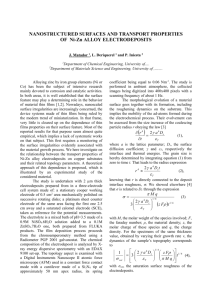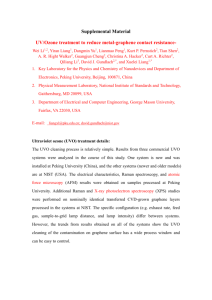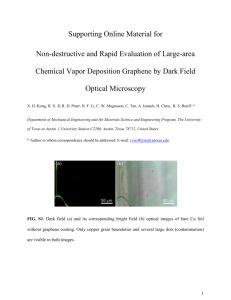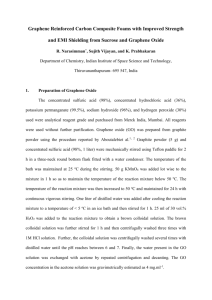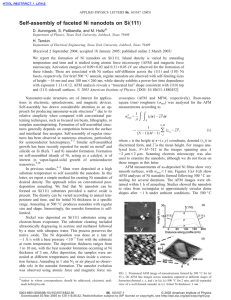supporting information
advertisement
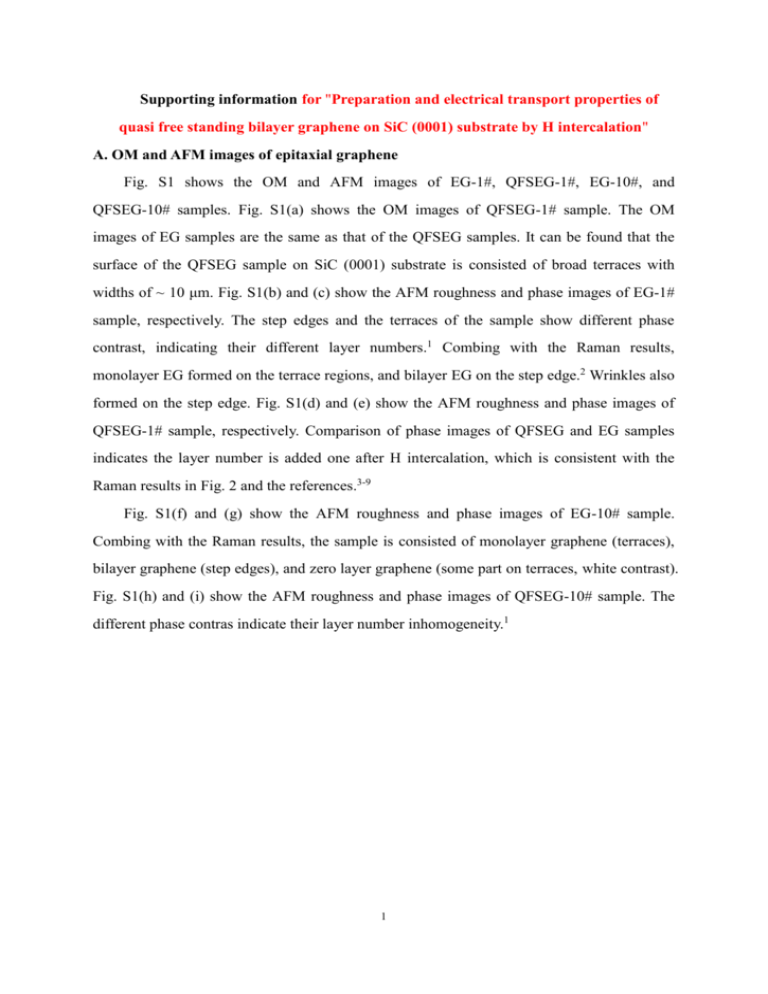
Supporting information for "Preparation and electrical transport properties of quasi free standing bilayer graphene on SiC (0001) substrate by H intercalation" A. OM and AFM images of epitaxial graphene Fig. S1 shows the OM and AFM images of EG-1#, QFSEG-1#, EG-10#, and QFSEG-10# samples. Fig. S1(a) shows the OM images of QFSEG-1# sample. The OM images of EG samples are the same as that of the QFSEG samples. It can be found that the surface of the QFSEG sample on SiC (0001) substrate is consisted of broad terraces with widths of ~ 10 μm. Fig. S1(b) and (c) show the AFM roughness and phase images of EG-1# sample, respectively. The step edges and the terraces of the sample show different phase contrast, indicating their different layer numbers.1 Combing with the Raman results, monolayer EG formed on the terrace regions, and bilayer EG on the step edge.2 Wrinkles also formed on the step edge. Fig. S1(d) and (e) show the AFM roughness and phase images of QFSEG-1# sample, respectively. Comparison of phase images of QFSEG and EG samples indicates the layer number is added one after H intercalation, which is consistent with the Raman results in Fig. 2 and the references.3-9 Fig. S1(f) and (g) show the AFM roughness and phase images of EG-10# sample. Combing with the Raman results, the sample is consisted of monolayer graphene (terraces), bilayer graphene (step edges), and zero layer graphene (some part on terraces, white contrast). Fig. S1(h) and (i) show the AFM roughness and phase images of QFSEG-10# sample. The different phase contras indicate their layer number inhomogeneity.1 1 (a) (b) (c) (d) (e) 2 (f) (g) (h) (i) FIG. S1 OM and AFM roughness and phase images of the EG and QFSEG on SiC (0001). (a) OM images of QFSEG-1# sample. AFM roughness (b), and phase (c) images of EG-1# sample. AFM roughness (d), and phase (e) images of QFSEG-1# sample. AFM roughness (f), and phase (g) images of EG-10# sample. AFM roughness (h), and phase (i) images of QFSEG-10# sample. B. Raman spectra of epitaxial graphene Fig. S2 shows the Raman spectra of the EG-1# and EG-6# samples. The defect induced D-peak of the EG-1# sample is lower than EG-6# sample, indication the fewer defects and good crystal of EG-1# sample. 3 EG-1# EG-6# 0.08 Intensity 0.06 0.04 0.02 0.00 1500 2000 -1 2500 3000 Peak shift (cm ) FIG. S2 Raman spectra of EG-1# and EG-6# samples. C. Simulation details of carrier mobility for the quasi-free standing bilayer graphene samples We fit the measured carrier mobility using the equation 1 1 c1 RP gr1 (S1) Our analysis of Coulomb scattering follows the analysis in Ref. 10, 11. As stated by W. Zhu et al, for bilayer and trilayer graphene, due to the parabolic band structure, the energy averaging of the Coulomb scattering time can result in the mobility increasing proportionally to temperature: k BT . And for uncorrelated impurities, the mobility is inversely proportional to the impurity density nimp.11 In Ref. 12, at high temperatures, the average relaxation time results in the substitution E→kBT which gives the mobility 8h s2 k B T, Z i2 e3 m*nimp where εs is the permittivity of the semiconductor and Zi is the charge state of the impurity. But if we fit the mobility using c c B T , no good fitting can be reached. Usually nimp A B T nimp (S2) is used for simulation, and A and B are constants.10, 11 The values of A, B, and nimp are not unique due to they are numerator and denominator 4 of the same fraction, respectively. They will show fold change. In the simulation, the value of B is first calculated by B 8h s2 k B , and fine tuning of B values are done in the simulation. Zi2e3m* The simulation values of A and B are shown in Table S1. Table S1. Fitting values of the A and B for the QFSEG samples. fitting parameter QFSEG-1# QFSEG-2# QFSEG-5# QFSEG-6# QFSEG-10# A (1012/(V·s)) 14882 15007 15000 15001 15008 B (1012/(V·s·K)) 14.8 8.7 7.0 5.9 5.0 References 1 S. Tanabe, Y. Sekine, H. Kageshima, M. Nagase, and H. Hibino, Phys. Rev. B 84, 115458 (2011) 2 C. Yu, J. Li, Q.B Liu, S.B. Dun, Z.Z. He, X.W. Zhang, S.J. Cai, and Z.H. Feng, Appl. Phys. Lett. 102, 013107 (2013) 3 C. Riedl, C. Coletti, T. Iwasaki, A.A. Zakharov, and U. Starke, Phys. Rev. Lett. 103, 246804 (2009). 4 F. Speck, J. Jobst, F. Fromm, M. Ostler, D. Waldmann, M. Hundhausen, H. B. Weber, and Th. Seyller, Appl. Phys. Lett. 99, 122106 (2011) 5 C. Virojanadara, R. Yakimova, A.A. Zakharov, and L.I. Johansson, J Phys. D: Appl. Phys. 43, 374010 (2010) 6 S. Forti, K.V. Emtsev, C. Coletti, A.A. Zakharov, C. Riedl, and U. Starke, Phys. Rev. B 84, 125449 (2011). 7 D.Waldmann, J. Jobst, F. Speck, T. Seyller, M. Krieger, H. Weber, Nat. Mater. 10, 357 (2011). 8 J.A. Robinson, M. Hollander, M. LaBella, K.A. Trumbull, R. Cavalero, and D.W. Snyder, Nano Lett. 11, 3875 (2011). 9 J. Ristein, S. Mammadov, and Th. Seyller, Phys. Rev. Lett. 108, 246104 (2012). 10 W. Zhu, V. Perebeinos, M. Freitag, and P. Avouris, Phys. Rev. B 80, 235402 (2009). 11 S. Xiao, J. Chen, S. Adam, E.D. Williams, and M.S. Fuhrer, Phys. Rev. B 82, 041406(R) (2010). 5 12 D. Ferry, Transport in Nanostructure, Cambridge University Press, Cambridge, England, (2009) Chap. 2 6
